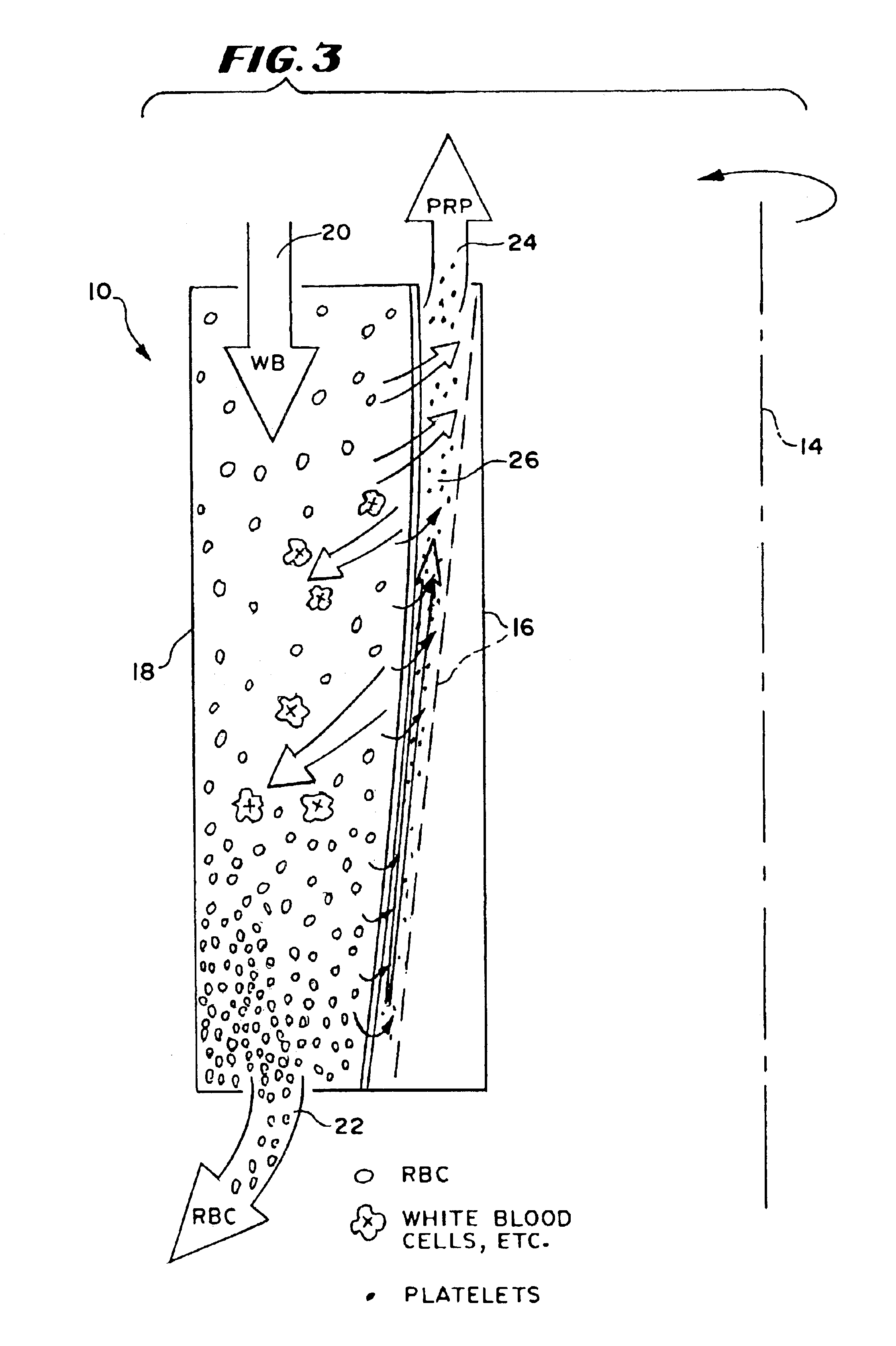Blood processing systems and methods
a centrifuge and processing system technology, applied in the direction of centrifugal force sediment separation, feed/discharge of settling tanks, other blood circulation devices, etc., can solve the problems of time-consuming and laborious loading and unloading operations, inconvenient handling, and inconvenient handling. , to achieve the effect of convenient handling
- Summary
- Abstract
- Description
- Claims
- Application Information
AI Technical Summary
Benefits of technology
Problems solved by technology
Method used
Image
Examples
example 1
[0138]A study compared the conventional 200 ml A-35 chamber to the 30 ml, reduced depth chamber described above (which will be called the “30 ml Chamber”). Both chambers had a collection area of 160 cm2.
[0139]The study used a paired run protocol. During the protocol, 59 normal donors underwent a platelet collection procedure with the A-35 chamber. The same donors underwent another platelet collection procedure with the 30 ml Chamber. The order of the collection procedures was randomized among the donors, with the procedures performed about a month apart.
[0140]Both procedures were conducted on a CS-3000® Centrifuge operated at a speed of 1600 RPM. All operating parameters for the first procedure were repeated in the second procedure. Six different blood centers participated in the study.
[0141]The results were correlated and statistically verified.
[0142]The study showed that the 30 ml Chamber provided significantly improved platelet collection. Compared to the A-35 Chamber, the 30 ml ...
example 2
[0287]A study evaluated a two stage separation chamber 74 like that shown in FIG. 16 in a platelet collection procedure on a healthy human donor. The chamber 74 was part of a double needle system 152, like that shown in 28. The system 152 recirculated PRP in the manner shown in FIG. 28 to obtain a hematocrit of 32.1% in the PRP collection region 124 of the chamber 74.
[0288]In this study, the low-G wall 64 of the first stage chamber 84 was not tapered in the direction of circumferential flow from the PRP collection region 124. The low-G wall 64 was isoradial along the circumferential flow path in the first stage chamber 84, except for the presence of a RBC barrier 128, which stepped into the chamber across the RBC collection passage, as shown in FIG. 17. The low-G wall 64 was isoradial along the entire circumferential flow path of the second chamber 86.
[0289]FIG. 35A shows the platelet count sampled in the PRP (in 1000 platelets per uL) over time during the 45 minute procedure. As th...
example 3
[0295]Another study evaluated a two stage separation chamber like that in Example 2 in a platelet collection procedure on a healthy human donor. As in Example 2, a double needle system was used. The system recirculated PRP to obtain an inlet hematocrit of 34.3%.
[0296]In this study, the low-G wall 64 of the first stage chamber 84 was tapered in the direction of circumferential flow from the PRP collection region 124, like that shown in FIG. 17. The low-G wall 64 also included RBC barrier 128 like that shown in FIG. 17. The low-G wall 64 was also tapered along the entire circumferential flow path of the second chamber 86.
[0297]FIG. 36A shows the platelet count sampled in the PRP (in 1000 platelets per uL) over time during the 45 minute procedure. As there shown, a platelet count of 300 was achieved in the first 5 minutes of the procedure. The platelet count peaked at 331 after 21 minutes. At the end of the procedure, the platelet count was 302.
[0298]FIG. 36B shows the physical size of...
PUM
| Property | Measurement | Unit |
|---|---|---|
| volume | aaaaa | aaaaa |
| depth | aaaaa | aaaaa |
| volume | aaaaa | aaaaa |
Abstract
Description
Claims
Application Information
 Login to View More
Login to View More - R&D
- Intellectual Property
- Life Sciences
- Materials
- Tech Scout
- Unparalleled Data Quality
- Higher Quality Content
- 60% Fewer Hallucinations
Browse by: Latest US Patents, China's latest patents, Technical Efficacy Thesaurus, Application Domain, Technology Topic, Popular Technical Reports.
© 2025 PatSnap. All rights reserved.Legal|Privacy policy|Modern Slavery Act Transparency Statement|Sitemap|About US| Contact US: help@patsnap.com



